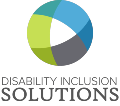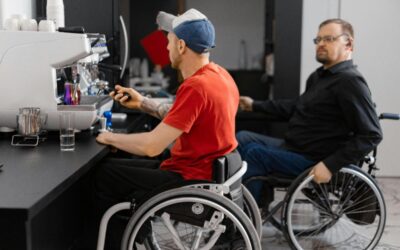How much to do you about the Committee for Purchase from People Who Are Blind or Severely Disabled? It’s an independent federal agency that dates back to the Roosevelt administration. Back when I was the Chairman, I appeared on TV to discuss the many facets of the committee and the job opportunities it creates for people with disabilities.
Video with captions:
Video transcript:
JOE KREBS: Good morning. Welcome to Viewpoint on this Sunday morning. I’m Joe Krebs and today we’re going to be getting the viewpoints of our guests on the topic of persons with disabilities but more specifically, employment for persons with disabilities, a really sort of intriguing topic that has a lot of complexity to it and you’re going to hear about some of that.
First of all, meet our guests. Tina Ballard is with us. She is the Executive Director of the – ready – Committee for Purchase from People Who Are Blind or Severely Disabled.
And also meet Andrew Houghton. He is the Chairperson of the Committee for Purchase from People Who Are Blind or Severely Disabled. Thank you both very much for joining us.
TINA BALLARD: Thank you.
ANDREW HOUGHTON: Thank you, Joe.
JOE KREBS: Good to have you with us. I want to spend some time, just a moment, explaining what that long title means and where that came from, but I also – but before we get to that, let’s talk a little bit about what the issue is here. Describe whether there is an employment or unemployment problem for persons with disabilities. What is the employment situation people with disabilities face?
ANDREW HOUGHTON: Well, there’s – it’s multifaceted. The unemployment rate of individuals with disabilities, if we take some of the numbers that are most well-known, roughly 30 million working age adults with disabilities in America and of that population, there is roughly 50% who are unemployed. So, it is a significant number of individuals. Of course, disability crosses every area. It could be cognitive, physical disability like myself, someone who is blind with – or hard of hearing, developmental disabilities, and other disabilities across the gamut. So, it is a significant problem in America and of course, with the aging population, people are living much longer so with that inherently comes disabilities along with that, that population, and we will be seeing an increased population of individuals with disabilities in the coming years.
JOE KREBS: I was going to say; is that population growing? I’m immediately thinking of the Iraq War and Afghanistan War. So many young men and women coming back with severe injuries.
ANDREW HOUGHTON: It is growing. It is a number that will continue to grow. I’m not an expert in that area but I do know that you know, after many of the – after the World Wars, that disability was brought to the attention of the American population and I think that is – that is consistent today with our dedicated veterans who are returning from Afghanistan and Iraq with significant disabilities and a lot of them with significant traumatic brain injuries which are often a very complex disability in trying to rehabilitate and reintegrate into society, let alone – let alone work.
JOE KREBS: Let me ask – maybe Tina could add to this too. What is the effect on persons with disabilities of not being employed? If 50% of those who have disabilities in the United States are not working, what is the effect on that population?
TINA BALLARD: Well, certainly it affects their independence. Income provides a considerable amount of independence to that body of people and with that comes, from talking to some people with disabilities, a sense of productivity. Talking to vets that come back from the war with disabilities, they want to take care of and provide for their families. And through the AbilityOne program, we’re able to help them do that.
JOE KREBS: And what – what does it – in terms of – what about just their economic wellbeing? If 50% are unemployed, are a large number of persons with disabilities living in extreme poverty? What do we know about that?
ANDREW HOUGHTON: Well, there is a significant gap in those with disabilities and the general population in terms of their income levels and poverty levels. Many individuals with disabilities still rely on social security or government run programs, subsidy program such as social security, disability, Medicaid, and Medicare. It is really, you know, a very complex subject to go into today but there are a lot of disincentives built into the system that discourage individuals from disabilities from going back to work, fear of losing health benefits, fear of losing their Medicaid and Medicare amongst many other barriers to individuals with disabilities going to work.
You can think about transportation. We could go on. Assistive technology. The – the attitudinal barriers that we often face. I mean, look at what just happened in Florida. There was a quadriplegic. The police dumped him out of his wheelchair.
JOE KREBS: A lot of us have seen that. Horrible, horrible video.
ANDREW HOUGHTON: Yeah, and it’s just a – a curve that is – has really taken decades and it has come a long way over the last several decades but we have a long ways to go.
JOE KREBS: Well, we need to take a break right now. We will come back and talk more about it and get a definition of the Committee for Purchase from People Who Are Blind or Severely Disabled when we come back. Stay with us. We’ll be right back.
Welcome back to Viewpoint on this Sunday morning. We’re talking about persons with disabilities and especially the employment of persons with disabilities and we’re talking with right now, Tina Ballard who is the Executive Director of the Committee for Purchase from People Who Are Blind or Severely Disabled.
Ms. Ballard, if you would, define what that title means?
TINA BALLARD: The purpose of the committee is to provide job opportunities for people who are blind or have severe disabilities and the title refers to this because through the program, federal procurement dollars provide job opportunities for people with disabilities or who are blind.
JOE KREBS: Okay. Who setup the committee? What is it a committee of?
TINA BALLARD: Well, it is a committee of about fifteen members and actually, this goes back to President Roosevelt’s time when he setup a program that would provide jobs for people who are blind making brooms and mops. And then we had the Javits-Wagner-O’Day Act which took us further along in the evolution of providing jobs through federal procurement dollars.
JOE KREBS: Okay. Is it a – when I said a committee of, what is it connected to? A committee of what organization or what board or what group?
ANDREW HOUGHTON: The Committee for Purchase from People Who Are Blind or Severely Disabled is an independent federal agency.
JOE KREBS: Oh, it is a federal agency?
ANDREW HOUGHTON: It’s a federal agency and we are comprised of fifteen of us presidential appointees of whom I am the chairman of the committee. We have a small staff of thirty. We’re one of the smaller federal agencies that exist and – and our responsibility is as the oversight agent of this program responsible to the president and congress to ensure the – the employment of individuals with disabilities through the federal procurement channels as well as the – overseeing the – the oversight responsibilities and the integrity and the compliance of our nonprofit agencies to participate in this program.
JOE KREBS: What are the programs that you – that this committee oversees?
TINA BALLARD: We oversee the purchase of the products. There is actually a procurement list and members of the federal government who buy things that are on the list, they provide the jobs through purchasing them. So, we oversee addition of things to the procurement list that will be bought through the federal government and then we interface with the National Industries for the Blind and NISH who are two central nonprofit agencies I believe Andy mentioned earlier.
They work with several six hundred companies across the United States, Puerto Rico, and Guam, and those agencies also provide jobs for people who are blind and have severe disabilities.
JOE KREBS: This program, as you mentioned earlier on, started making brooms and mops. What kinds of products are being made now?
ANDREW HOUGHTON: We produce – our nonparticipating, nonprofit agencies produce essentially anything the government buys, from your standard products, pens, paper. We – we produce bio chem suits for the military, M16 cartridges. We also perform a lot of services. For example, we have some janitorial environmental services, Library of Congress, Statue of Liberty, go on and on. Most military bases around the country utilize our products or services as well as do many of the federal agencies, IRS, secure mailroom, you name it. Anything the federal government purchases, individuals with disabilities are often a part of providing that product or service.
JOE KREBS: Are government agencies required to purchase from the companies under the committee?
TINA BALLARD: They are required to purchase from the procurement list, those items which are made by the companies under the committee.
JOE KREBS: So, well, does that mean that all products – among the things that you listed, are those – those are all purchased from your companies by the government? Are other – are you in competition with other private companies?
ANDREW HOUGHTON: We are one of many sources available to the federal customer to provide a product, a good, or a service. Once it is – it’s a very complicated program, but once the customer agrees with one of our providing/producing nonprofit agencies on a product or service that they procure, it then gets added to something called the procurement list which once added to the procurement list, the government is – is required to buy from us in certain product lines such as pens and paper. They are required to first buy from the AbilityOne program producing agencies and then if it is not available, they can then go to other sources.
JOE KREBS: Very interesting. Well, we’re going to take a break now, come back, and talk more about this, perhaps find out exactly how many people are employed by these programs. Stay with us. We’ll be right back.
Welcome back to Viewpoint on this Sunday morning. We’re talking about employment of persons with severe disabilities, blindness or severe disabilities, and you were talking about this program that sells things to the federal government. How many people are employed around the country selling these kinds of products to the government?
TINA BALLARD: Forty thousand today.
JOE KREBS: Forty thousand?
TINA BALLARD: More than forty thousand and this is really significant because in the last fifteen years, that is a number that has grown from twenty-two thousand.
And another thing that I find very significant is that fifteen years ago, the wages through this program were about $80 million. Today, it is over $400 million. The average hourly wage was five dollars. Today, the average hourly wage is ten dollars. So, we have seen a lot of growth in the program over the last fifteen years.
JOE KREBS: Now, is their only customer the federal government or can these companies that work, these nonprofits that work under this law, also sell to others for greater profit?
ANDREW HOUGHTON: They can sell. They often, our nonprofits, for example, here locally, Service Source, they have multiple – multifaceted business and rehabilitation services programs. They have projects and services through the AbilityOne program but they are also providing products and services to the commercial sector as well. Then they also have a whole array of rehabilitation services.
The AbilityOne program is really a continuum in the services that are available to individuals with significant disabilities who we employ.
JOE KREBS: Yeah, explain – let’s just pause and explain what AbilityOne refers to. You’ve got the pin on your lapel and we’ve talked about AbilityOne, but what exactly is AbilityOne and how is that distinguished from the committee that we’re talking about?
ANDREW HOUGHTON: Well, as we said earlier, the committee for Purchase is the oversight body. AbilityOne is the name of our program. For years, we were known by our founding – our founding fathers, the Javits – Senators Javits, Wagner, and O’Day, and we were known as the Javits-Wagner-O’Day Act and people called us JWOD. And many people in the federal government still know us as JWOD.
Several years ago, we underwent a branding initiative and the result was our new name, AbilityOne. We really felt that it signified the individuals and their capabilities and their ability to achieve their maximum potential through our program and so, AbilityOne is the name of our program, just like you would any other – you know, any other entity.
JOE KREBS: Okay. And the goal again is to produce products that can be sold to the federal government?
ANDREW HOUGHTON: Yes.
JOE KREBS: And the enormous reach of the federal government? How about efforts to find jobs in companies that are not selling to the federal government, getting employment for people in – in businesses that are not involved with selling to the federal government? Is that just something out of your bailiwick?
ANDREW HOUGHTON: No, actually most of our participating nonprofit agencies have placement programs and often, some of the individuals who had been employed in our program will decide they want to try something new. So, the nonprofit agency affords them the opportunity to work in – in their local community. If they want to work anywhere, you know, at a grocery store to – to a large corporation, that nonprofit has relationships generally with their local community and tries to place them in a job that meets their interests and their desires.
Now, on the other side of that, you know, the unemployment rate being as significant as it is for individuals with disabilities, I would say that business – there has been efforts for years to increase the awareness among business to employ more people with disabilities and you know, it is getting better but we have a long ways to go. And I think that individuals in the workforce really need to better understand the capabilities of people like myself and other disabilities, that we can be contributing members of the workforce. And that is hard – you know, that is a hard nut to crack sometimes.
JOE KREBS: It really is. I want to talk more about that in just a little bit but let me ask Tina Ballard about how you talked about the growth of the program over the last ten years or so. What is it going to take to continue to grow it? What kinds of things need to happen or would you like to see happen?
TINA BALLARD: Well, I would like to see a growth in the commitment and ownership to the program within the federal government. We have seen a lot of commitment but for example, in the Department of Defense where I am coming from into the program, the Director of Defense Procurement this week made a commitment that he wants to see the numbers in the department double which means we would double the number of opportunities to people who are blind and have severe disabilities.
What is significant about that is today, we have about $2 billion worth of sales and that would take that number to $4 billion and perhaps take the number of job opportunities up over 80,000. That would be a wonderful growth for us to see in the program.
And I think we can accomplish that through our work with the committee and the federal officials such as Mr. Asad (ph) in the department, as well as Stephanie Locke (ph) who is on our staff and in charge of communications. We’re going to get the word out and get the work in.
JOE KREBS: Are there enough people out there to staff those additional positions that you want to fill and enough nonprofits who will produce quality products for the federal government?
TINA BALLARD: That is a really good question because we have to maintain a balance between capacity and also employees that can do the work. Part of the things that happen to the program is training and recruitment, increasing the number of hours. So, yes, we have to work all of that together.
JOE KREBS: Yeah. Well, we need to take another break right now and we will and be right back. Stay with us.
Good morning and welcome back to Viewpoint on this Sunday morning. We’re talking about employment of persons with disabilities. Let’s talk a little bit – we haven’t really talked a whole lot about this. Outside of this particular program that you have, what is the state today of discrimination against persons with disabilities?
You mentioned that video that we saw earlier this week of a police officer or a sheriff’s deputy or whatever that was, a person in a police station just dumping a quadriplegic out of a wheelchair onto the floor in the police station. A horrific picture. I mean, that is pretty drastic but what other kinds of – what is the state of discrimination against persons with disabilities?
ANDREW HOUGHTON: Well, you know, it is really an individual basis. It is attitudinal. I have been a wheelchair now a little over twenty years and I can honestly say that I haven’t been faced with really as blatant discrimination such as we saw this week. However, just several months ago, I went to water ski. I am an avid sports – sports guy and I went to water ski at a park with cables and I brought my ski up and I went in and I said what does it cost to ski? They said I’m sorry, we don’t allow handicapped people to ski here.
Really, I think it was an unfortunate mistake and it was miscommunication and I don’t think they really intended to discriminate. Nevertheless, it occurred. And someone like me who has been around, you know, I was able to you know, I was impacted by it and it really set me back. I said boy, what about people that have to deal with this on a daily basis that have far more significant disabilities who can’t jump up a curb or who use a power wheelchair or who face discrimination on a daily basis?
The bottom line is it still exists and we need to continue to educate and inform and at worst case scenario, people need to you know, to – to adjudicate it through the appropriate means.
JOE KREBS: We’re talking about employment here and jobs and what – how much of a hurdle is it for a person with disabilities to even just get over that hurdle into the employment process in terms of an interview and all – I mean, do – how much of a barrier is it to just even get – to get considered for a job?
ANDREW HOUGHTON: Well, since the passing of the Americans with Disabilities Act over seventeen years ago, the life has gotten much easier for folks. There are ramps that are required, accessibility. Physical access is there. That is generally not the biggest problem.
JOE KREBS: But I am talking about the attitudinal barrier.
ANDREW HOUGHTON: Well, it’s – it’s an issue because you know, you – people have perceptions of someone, you know, whether it is a disability or whether they are blind or whether they are deaf. They have a perception that you can’t do something. So, most of the time you have to prove notwithstanding, you know, the length of your resume and the number of degrees that you have, you still have to prove that you can achieve, I believe. So, we have a much higher bar that we have to – to aspire to. And that is something that really is just going to take time.
As the playing field gets leveled, as technology makes – makes – makes things more equal for individuals with disabilities, you know, computer software, phones, ultimately that combined with increased education and better laws, we will, you know, we will hopefully achieve a higher level of success.
JOE KREBS: I want to put a full screen picture – slide on the screen to let people know where they can get more information about the AbilityOne program. You can do that by going on the web to AbilityOne dot gov or you can call 703-603-7740.
And I would like to ask Tina Ballard, the viewers who are sitting out there watching, is there anything viewers can do to sort of – who think this is a wonderful program to get involved and sort of help the program along?
TINA BALLARD: Well, it is always important for viewers to express their support to members of the legislative body. Money is important to all of the things that we do because money generates jobs and so, that is the way that citizens can get involved. Andy?
JOE KREBS: And the nonprofits can always use donations.
ANDREW HOUGHTON: Yeah. And that’s – that would be based on their local missions and their support and their boards. People really, I think, just need to understand the value of the human life and as one of our customers said, we don’t look at it as people with disabilities helping us in the military. We look at it as Americans helping Americans.
JOE KREBS: Let’s leave it at that. Thank you very much, both of you, for joining us today to talk about this very important issue. Thank you so much.
Thank you for joining us as well and now we’re going to send you back to News 4 Today. Hope you have a terrific Sunday. Thanks.





0 Comments